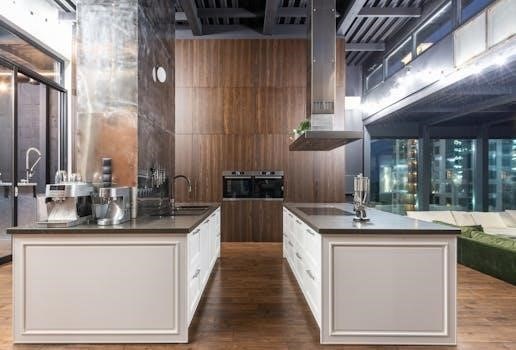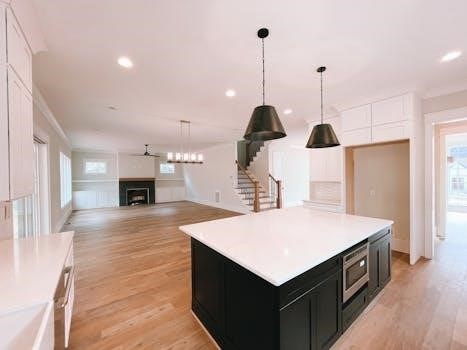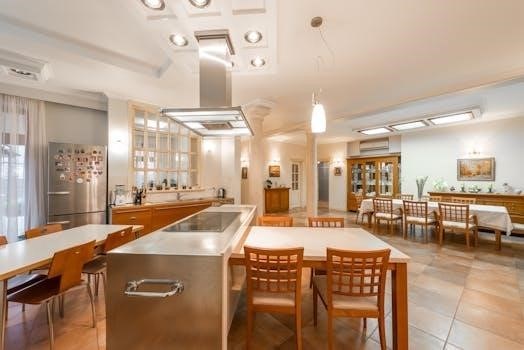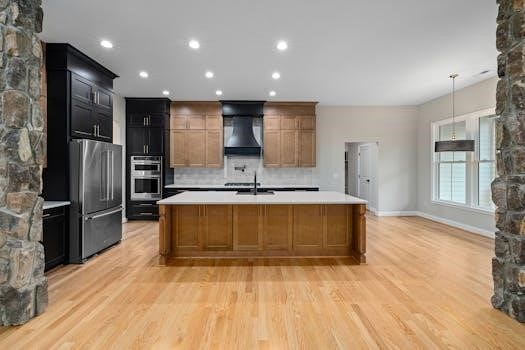kitchen island plans pdf

Kitchen Island Plans PDF⁚ A Comprehensive Guide
This comprehensive guide explores kitchen island plans, focusing on dimensions, heights, layouts, and design features. Discover how to create a functional and stylish island with our detailed PDF resources and expert tips.
Standard Kitchen Island Dimensions
Understanding standard kitchen island dimensions is crucial for planning a functional and aesthetically pleasing space; While there isn’t a single “standard” size, average dimensions provide a useful starting point. A typical island measures around 40 inches wide and 80 inches long, with a countertop height of 36 inches. However, these dimensions vary widely based on kitchen size and layout. The minimum functional island size is generally considered to be about 2 feet by 4 feet. Most homeowners prefer a slightly larger island, often around 3 feet by 6.5 feet, to accommodate both seating and storage. The clearance around the island is also essential, typically ranging from 36 to 42 inches to allow comfortable movement and accessibility. The dimensions should be adapted to your kitchen’s unique layout and the available space. Remember, planning for adequate walking space around the island is as important as the island’s size itself.

Average Island Size
When considering the average island size, it’s important to note that this isn’t a one-size-fits-all measurement, but rather a common starting point. Generally, the average kitchen island measures about 80 inches in length and 40 inches in width. This size provides a good balance between functionality and space utilization for most kitchens. The countertop height for these average islands is typically around 36 inches, offering comfortable working space. Remember that adequate clearance, typically around 36 to 42 inches, should be maintained around the island to ensure ease of movement. These average dimensions can be adjusted based on individual preferences and the specific layout of the kitchen. While these figures serve as a guide, the final size should be tailored to fit your space and your needs. The goal is to create an island that feels balanced and efficient within your kitchen.
Minimum Functional Island Size
Determining the minimum functional island size is crucial for kitchens with limited space. A functional island should be at least 2 feet wide and 4 feet long, providing a compact yet practical surface. This minimum size allows for basic tasks and some storage. While this is the smallest recommended size, it’s important to consider clearance around the island. A minimum of 36 inches, and preferably 42 inches of clearance on all sides is necessary for comfortable movement. Counter height should remain around 36 inches. When planning a smaller island, prioritize functionality to ensure it’s a useful addition to your kitchen. Think about how you’ll use it and choose dimensions that make sense for those activities. Even a smaller island can significantly enhance a kitchen.
Clearance Around the Island
Adequate clearance around a kitchen island is essential for comfortable movement and functionality. A minimum of 36 inches of clearance on all sides is recommended, but 42 inches is preferable for busy kitchens with multiple cooks. These measurements ensure that people can easily walk around the island, open cabinet doors and appliances, and use it as a functional workspace. Sufficient clearance also prevents bottlenecks and makes the kitchen feel more open and inviting. Consider the flow of traffic and the paths of movement while planning your clearance. Proper clearance contributes to a safe and effective kitchen layout. Failure to do so may cause discomfort and restrict movement.
Kitchen Island Height
The height of a kitchen island is a critical factor for comfort and usability, and it should be carefully considered. Standard counter height is typically 36 inches, which is suitable for most food preparation tasks. However, islands can also be designed with bar height, which is around 42 inches. This is great for casual seating and dining. The purpose of the island will influence the ideal height. For instance, if you plan to use it primarily for dining, consider a height that is comfortable for sitting and eating. These height variations are important to consider for functionality and aesthetics.
Standard Counter Height

The standard counter height for a kitchen island is typically 36 inches. This height is designed to match the height of most kitchen countertops, creating a seamless work surface. This standard height works well for a range of tasks, including chopping, mixing, and general food preparation. It allows most adults to comfortably work at the island without needing to bend over or reach too high. This height is also suitable if you plan to incorporate a sink into your island. When planning the height, also consider the height of your stools or chairs if you plan to include seating. This will ensure a comfortable experience while working or dining at the island.
Bar Height Considerations
Bar height for kitchen islands typically measures around 42 inches, creating a more casual and elevated seating area; This increased height is ideal for bar stools and offers a distinct separation from the standard counter height. When considering a bar height, ensure you choose the correct seating. Bar stools need to be taller than standard counter stools to match the height. Incorporating a bar-height section can create a social hub within the kitchen, perfect for conversations and casual dining. This height is also good if you want to disguise kitchen mess as it will be higher up and less obvious. Ensure the overhang allows for comfortable leg room.

Height for Dining Purposes
When using a kitchen island for dining, the standard counter height of 36 inches is often suitable, however it can be raised to 42 inches. This height allows for comfortable seating using standard dining chairs or counter stools. Consider the legroom needed when designing for dining, ensuring adequate overhang for comfortable seating. A dining-height island integrates seamlessly with the kitchen space, providing a casual and convenient eating area. Choosing a height suitable for dining ensures a comfortable experience for everyone. Make sure to choose the proper seating for the height. A standard height allows for children and older people to use the island comfortably. The height should allow for comfortable eye contact when dining.
Island Size Based on Kitchen Layout
The size of your kitchen island should be proportionate to your kitchen’s overall dimensions. A large kitchen can accommodate a more substantial island, while a smaller kitchen requires a more compact design. It’s crucial to consider the space needed for comfortable movement around the island, typically a minimum of 36 to 42 inches, along all sides. An island should not be so large that it impedes the flow of traffic. The island should be a part of the kitchen, not an obstruction. The island’s size should be based on a ratio to the kitchen’s size. This ensures it fits seamlessly and allows for efficient use of the space. The island’s size also impacts the functionality of the kitchen.
Space Required for an Island
Determining the space required for a kitchen island is crucial for functionality and flow. A minimum of 36 to 42 inches of clearance should be maintained on all sides of the island to allow for comfortable movement and to prevent the space from feeling cramped. The island’s dimensions should also correlate to the overall kitchen size, ensuring that it doesn’t overwhelm the area. In smaller kitchens, a more compact island or even a kitchen cart may be more appropriate. The area should be measured carefully and you should plan with the dimensions of the island in mind. Avoid overcrowding by making sure you leave enough space. Consider the placement of other kitchen features when planning your island.
Island Size and Kitchen Size Ratio
The ratio between the kitchen island size and the overall kitchen size is vital for a balanced design. An island shouldn’t dominate a small kitchen, nor should it appear insignificant in a larger one. A general rule is that the island’s total area should not exceed 10% of the kitchen’s total floor space. In a smaller kitchen, a narrow island may be more suitable while a larger kitchen can handle a more substantial design. The space should also be proportional to the size of other elements in the room, so be sure to keep this in mind during the planning process. The island should feel like a natural extension of the kitchen.
Design Features and Customization
Kitchen islands offer numerous opportunities for customization, allowing homeowners to tailor the design to their specific needs and preferences. Overhangs for legroom are essential for comfortable seating, with recommendations varying between 15 inches for standard counter height and 12 inches for bar height. Seating capacity should be carefully considered, ensuring adequate space per person. Another customization option is combining the island with a dining table to save space and create a multi-functional area. Modular islands offer flexibility, while custom designs allow for unique dimensions and finishings. These features provide opportunities to create a personalized kitchen space.
Overhang for Legroom
Providing adequate legroom is crucial for comfortable seating at a kitchen island, directly influencing the usability and enjoyment of the space. The recommended overhang for standard counter height islands is generally a minimum of 15 inches, allowing ample space for knees and legs. For bar-height islands, a 12-inch overhang is typically sufficient. These dimensions are essential to avoid cramped conditions and ensure that seating is functional and comfortable for all users. Careful planning of the overhang is necessary to ensure both comfort and the overall aesthetic of the island.
Seating Capacity and Dimensions
Determining the seating capacity of a kitchen island is vital for functionality and comfort. The dimensions of the island directly impact how many people can comfortably sit and use the space. For a two-seat island, a length of around 48 to 60 inches is typically sufficient. As you add more seating, increase the length accordingly. Consider a minimum width of 24 inches per seat to ensure that each person has enough space without feeling crowded. Thoughtful planning of seating arrangements, and the appropriate dimensions for each seat are critical for optimizing both functionality and space.
Combining Island with Dining Table
Integrating a dining table with a kitchen island is a practical solution for saving space and creating a multi-functional area. This combination is ideal for smaller kitchens where a separate dining area isn’t feasible. By attaching a dining table to the island, you can seamlessly transition from food preparation to dining. Consider an extended countertop or a separate table attached at the end, allowing for both counter seating and a more traditional dining experience. This dual-purpose design encourages both casual interactions and more formal meals, maximizing space and functionality within the kitchen.
Kitchen Island Types
Kitchen islands come in various forms, each designed to meet specific needs and spatial constraints. Modular islands offer flexibility, allowing for easy rearrangement and customization. These are often pre-fabricated units that can be combined to fit different kitchen layouts. In contrast, custom islands are designed to meet specific dimensions and aesthetic preferences, integrating seamlessly with the kitchen’s design. These can be tailored to include unique features like built-in appliances, varied storage solutions, or custom finishings. Understanding these different types is crucial in choosing the perfect island for your kitchen.
Modular Kitchen Islands
Modular kitchen islands are a versatile option, offering pre-designed units that can be combined and rearranged to fit various kitchen layouts. These islands provide a cost-effective and flexible solution, allowing homeowners to customize their island’s size and configuration without the complexities of fully custom designs. Modular systems often come in standard sizes, making it easy to plan and install. They are ideal for those seeking a balance between customization and affordability. The modular nature also means they can be easily updated or reconfigured if needs change over time.
Customizable Dimensions and Finishings
Customizable dimensions and finishings offer the ultimate flexibility in kitchen island design, allowing homeowners to create a truly unique piece tailored to their specific needs and aesthetic preferences. With custom options, the island’s length, width, and height can be precisely adjusted to fit the kitchen’s layout and the user’s ergonomic requirements. Furthermore, a wide array of materials, colors, and finishes can be selected, ensuring the island seamlessly integrates with the overall kitchen design. This approach provides the opportunity to create an island that is not only functional but also a stunning focal point.

